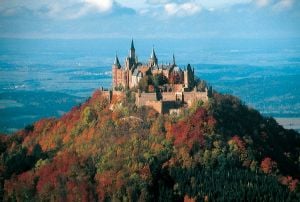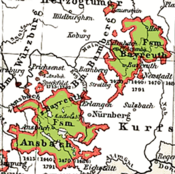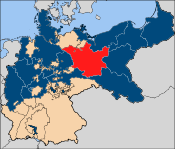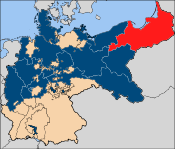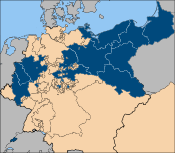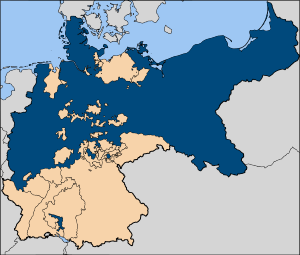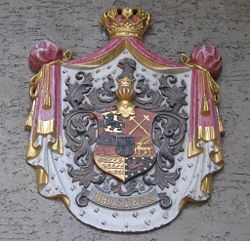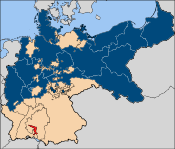House of Hohenzollern
The House of Hohenzollern is a noble family and royal dynasty of Prince-electors, kings, and emperors of Prussia, Germany, and Romania. It originated in the area around the town of Hechingen in Swabia during the eleventh century. They took their name from their ancestral home, the Burg Hohenzollern castle. The family split into two branches, the Catholic Swabian branch and Protestant Franconian branch. The Swabian branch ruled the area of Hechingen until their eventual extinction in 1869. The Franconian branch was comparatively more successful. Branches within the Franconian branch ascended the throne of Margravate of Brandenburg in 1415 and of the Duchy of Prussia in 1525. The union of these two Franconian branches, in 1618, allowed the creation of the Kingdom of Prussia in 1701, the state which led the unification of Germany and the creation of the German Empire in 1871.
Social unrest at the end of World War I led to the German Revolution of 1918, with the subsequent formation of the Weimar Republic forcing the Hohenzollerns to abdicate, thus bringing an end to the modern German monarchy. A member of the house ruled in Romania until 1947. Known for their love of the military, the Hohenzollern princes and emperors are said to have presided over an army with a country rather than a country with an army. By the end of the nineteenth century, Germany's military capability had one major goal, that of world domination. Any nation that arms with the goal of acquiring world power does so not to defend itself against aggression but to attack other nations. Militarism of this type endangers world peace and security. On the one hand, members of this lineage gave stable government to many people within the European space over a very long period of time. On the other hand, ambition, a dislike of democracy together with unwillingness to change with the times, brought Hohenzollern rule to an end.
Origins
Counts of Zollern (before 1061 until 1204)
The oldest known mentioning of the Zollern dates from 1061. It was a countship, ruled by the counts of Zollern. The accepted origin of the counts of Zollern is that they are derived from the Burchardinger dynasty.
- Until 1061: Burkhard I, Count of Zollern
- Before 1125: Frederick I (son of)
- Circa 1142 : Frederick II (son of)
- Before 1171-c. 1200: Frederick III/I (son of, also Burgrave of Nuremberg)
Count Frederick III of Zollern was a loyal retainer of the Holy Roman emperors Frederick Barbarossa and Henry VI and about 1185 he married Sophia of Raabs, the daughter of Conrad II, Burgrave of Nuremberg.
After the death of Conrad II, who left no male heirs, Frederick III was granted the burgraviate of Nuremberg in 1192 as burgrave Frederick I of Nuremberg-Zollern. Since then the family name became to be known as Hohenzollern.
After Frederick's death, his sons partitioned the family lands between themselves:
- The youngest brother, Frederick IV, received the county of Zollern and burgraviate of Nuremberg in 1200 from his father, thereby founding the Swabian branch of the House of Hohenzollerns. The Swabian line remained Catholic.
- The oldest brother, Conrad III, received the burgraviate of Nuremberg in 1218 from his younger brother Frederick IV, thereby founding the Franconian branch of the House of Hohenzollerns. The Franconian line later converted to Protestantism.
Franconian senior branch and Brandenburg-Prussian Branch
The senior Franconian branch of the House of Hohenzollern was founded by Conrad III, Burgrave of Nuremberg.
Beginning in the sixteenth century, this branch of the family became Protestant and decided on expansion through marriage and a purchase of surrounding lands.
The family were supporters of the rulers from the House of Hohenstaufen and the House of Habsburg of the Holy Roman Empire during the twelfth to fifteenth centuries, by which they were rewarded with several territorial benefits.
In a first phase, the family gradually added to their lands, at first with many small acquisitions in the Franconian and Bavarian regions of Germany:
- Ansbach in 1331
- Kulmbach in 1340
In a second phase, the family expanded their lands further with large acquisitions in the Brandenburg and Prussian regions of Germany and Poland:
- Margraviate of Brandenburg in 1417
- Duchy of Prussia in 1618
These acquisitions were to eventually propel the Hohenzollerns from a minor German princely family into one of the most important in Europe.
Burgraves of Nuremberg (1192-1427)
- 1192–1200/1204: Frederick I/III (also count of Zollern)
- 1204–1218: Frederick II of Nuremberg (son of, also count of Zollern)
- 1218–1261/1262: Conrad I of Nuremberg (brother of, also count of Zollern)
- 1262–1297: Frederick III of Nuremberg (son of)
- 1297–1300: John I of Nuremberg (son of)
- 1300–1332: Frederick IV of Nuremberg (brother of)
- 1332–1357: John II of Nuremberg (son of)
- 1357–1398: Frederick V of Nuremberg (son of)
At Frederick V's death on January 21, 1398, his lands were partitioned between his two sons:
- 1398-1420: John III/I (son of, also Margrave of Brandenburg-Kulmbach)
- 1420-1427: Frederick VI, (brother of, also Elector of Brandenburg and Margrave of Brandenburg-Asbach)
After John III/I's death on June 11, 1420, the two principalities were shortly reunited under Frederick VI. From 1412 Frederick VI became Margrave of Brandenburg as Frederick I and Elector of Brandenburg as Frederick I. From 1420 he became Margrave of Brandenburg-Kulmbach. Upon his death on September 21, 1440, his territories were divided between his sons:
- John II, Margrave of Brandenburg-Kulmbach
- Frederick II, Elector of Brandenburg
- Elector of Brandenburg and Margrave of Brandenburg-Ansbach
From 1427 onwards the title of Burgrave of Nuremberg was absorbed into the titles of Margrave of Brandenburg-Alsbach and Margrave of Brandenburg-Kulmbach.
Margraves of Brandenburg-Ansbach (1398-1791)
- 1398: Frederick I (also Margrave of Brandenburg-Kulmbach)
- 1440: Albert III, Margrave of Brandenburg (son of, also Margrave of Brandenburg-Kulmbach and Elector of Brandenburg)
- 1486: Frederick I, Margrave of Brandenburg-Ansbach (son of, also Margrave of Brandenburg-Kulmbach)
- 1515: George, Margrave of Brandenburg-Ansbach (son of, also Duke of Brandenburg-Jägerndorf)
- 1543: George Frederick, Margrave of Brandenburg-Ansbach (son of, also Margrave of Brandenburg-Kulmbach, Duke of Brandenburg-Jägerndorf and Regent of Prussia)
- 1603: Joachim Ernst, Margrave of Brandenburg-Ansbach
- 1625: Frederick II, Margrave of Brandenburg-Ansbach
- 1634: Albert, Margrave of Brandenburg-Ansbach
- 1667: John Frederick, Margrave of Brandenburg-Ansbach
- 1686: Christian Albrecht, Margrave of Brandenburg-Ansbach
- 1692: George Frederick II, Margrave of Brandenburg-Ansbach (later Margrave of Brandenburg-Kulmbach)
- 1703: William Frederick, Margrave of Brandenburg-Ansbach (before 1686-1723)
- 1723: Charles William Frederick, Margrave of Brandenburg-Ansbach (1712-1757)
- 1757: Christian Frederick, Margrave of Brandenburg-Ansbach (1757-1791) (son of, also Margrave of Brandenburg-Kulmbach)
On December 2, 1791, Christian II Frederick sold the sovereignty of his principalities to king Frederick William II of Prussia.
Margraves of Brandenburg-Kulmbach (1398-1604), later Brandenburg-Bayreuth (1604-1791)
- 1397: John III, Burgrave of Nuremberg
- 1420: Frederick I, Margrave of Brandenburg (also Margrave of Brandenburg-Ansbach)
- 1440: John, Margrave of Brandenburg-Kulmbach
- 1457: Albert III, Margrave of Brandenburg (also Margrave of Brandenburg-Ansbach and Elector of Brandenburg)
- 1464: Frederick II (also Elector of Brandenburg)
- 1486: Siegmund
- 1495: Frederick III/II (also Margrave of Brandenburg-Ansbach)
- 1515: Casimir, Margrave of Brandenburg-Bayreuth
- 1527: Albert Alcibiades, Margrave of Brandenburg-Kulmbach
- 1553: George Frederick, Margrave of Brandenburg-Ansbach (also Margrave of Brandenburg-Ansbach, Duke of Brandenburg-Jägerndorf and Regent of Prussia)
- 1603: Christian, Margrave of Brandenburg-Bayreuth
- 1655: Christian Ernst, Margrave of Brandenburg-Bayreuth
- 1712: George William, Margrave of Brandenburg-Bayreuth
- 1726: George Frederick Charles, Margrave of Brandenburg-Bayreuth (previously Margrave of Kulmbach)
- 1735: Frederick, Margrave of Brandenburg-Bayreuth
- 1763: Frederick Christian, Margrave of Brandenburg-Bayreuth
- 1769: Christian Frederick, Margrave of Brandenburg-Ansbach (until 1791, also Margrave of Brandenburg-Ansbach)
On December 2, 1791, Christian II Frederick sold the sovereignty of his principalities to king Frederick William II of Prussia.
Margraves and Electors of Brandenburg (1417-1806)
- 1415-1440: Frederick I of Brandenburg (also Margrave of Brandenburg-Kulmbach and Burgrave of Nuremberg)
- 1440-1470: Frederick II, Elector of Brandenburg (son)
- 1470-1486: Albert III Achilles, Elector of Brandenburg (brother) (also Margrave of Brandenburg-Kulmbach and Margrave of Brandenburg-Ansbach)
- 1486-1499: John Cicero, Elector of Brandenburg (son)
- 1499-1535: Joachim I Nestor, Elector of Brandenburg (son)
- 1535-1571: Joachim II Hector, Elector of Brandenburg (son)
- 1571-1598: John George, Elector of Brandenburg (son)
- 1598-1608: Joachim Frederick, Elector of Brandenburg (son, also Duke of Brandenburg-Jägerndorf and Regent of Prussia)
- 1608-1619: John Sigismund of Brandenburg (son, also duke of Prussia)
- 1619-1640: George William of Brandenburg (son, also duke of Prussia)
- 1640-1688: Frederick William of Brandenburg (son, also duke of Prussia)
- 1688-1701: Frederick I of Prussia (son, also Duke of Prussia and King in Prussia)
From 1701, the title of Elector of Brandenburg was attached to the title of King in and of Prussia.
Dukes of Brandenburg-Jägerndorf (1523-1622)
The Duchy of Brandenburg-Jägerndorf was purchased in 1523.
- 1541–1543: George, Margrave of Brandenburg-Ansbach (also Margrave of Brandenburg-Ansbach)
- 1543–1603: George Frederick, Margrave of Brandenburg-Ansbach (also Margrave of Brandenburg-Ansbach, Margrave of Brandenburg-Kulmbach and Regent of Prussia)
- 1603–1606: Joachim Friedrich (also Regent of Prussia and Elector of Brandenburg)
- 1606–1621: Johann Georg of Hohenzollern
The duchy of Brandenburg-Jägerndorf was confiscated by Ferdinand III, Holy Roman Emperor in 1622.
Margraves of Brandenburg-Küstrin (1535-1571)
The short-lived Margraviate of Brandenburg-Küstrin (principality) was set up, against the Hohenzollern house laws on succession, as a fief of the House of Hohenzollern, a typical German institution.
- 1535–1571: Johan the Wise, Margrave of Brandenburg-Küstrin (son of Joachim I Nestor, Elector of Brandenburg)
He died without issue. The Margraviate of Brandenburg-Küstrin was absorbed in 1571 into the Margraviate and Electorate of Brandenburg.
Margraves of Brandenburg-Schwedt (1688-1788)
From 1688 onwards, the Margraves of Brandenburg-Schwedt were a side branch of the House of Hohenzollern. The Margraviate of Brandenburg-Schwedt although it was never a principality with in its own right.
- 1688-1711: Philip William, Prince in Prussia, Margrave of Brandenburg-Schwedt (son of Frederick William, Elector of Brandenburg)
- 1731-1771 : Frederick William, Prince in Prussia, Margrave of Brandenburg-Schwedt (son of)
- 1771–1788 : Henry Frederick, Prince in Prussia, Margrave of Brandenburg Schwedt (son of)
In 1788 the title was incorporated into the Kingdom of Prussia.
Dukes of Prussia (1525-1701)
In 1525 the Duchy of Prussia was established as a fief of the King of Poland.
- 1525–1568: Albert I
- 1568–1618: Albert II Frederick co-inheritor (son of)
- 1568–1571: Joachim II co-inheritor (also Elector of Brandenburg)
- 1578–1603: George Frederick I (Regent, also Margrave of Brandenburg-Ansbach, Margrave of Brandenburg-Kulmbach and Duke of Brandenburg-Jägerndorf)
- 1603–1608: Joachim I/I/III Frederick (Regent, also Duke of Brandenburg-Jägerndorf and Elector of Brandenburg)
- 1608–1618: John I/III Sigismund (Regent, also Elector of Brandenburg)
- 1618–1619: John I/III Sigismund (Regent, also Elector of Brandenburg)
- 1619–1640: George William I/I (son of, also Elector of Brandenburg)
- 1640–1688: Frederick I/III William the Great (son of, also Elector of Brandenburg)
- 1688–1701: Frederick II/IV/I (also Elector of Brandenburg and King in Prussia)
From 1701, the title of Duke of Prussia was attached to the title of King in and of Prussia.
Kings in Prussia (1701-1772)
In 1701, the title of King in Prussia was granted, without the Duchy of Prussia being elevated to a Kingdom within the Holy Roman Empire. From 1701 onwards, the titles of Duke of Prussia and Elector of Brandenburg were always attached to the title of King in Prussia.
- 1701–1713: Frederick I/II/IV (also Duke of Prussia and Elector of Brandenburg)
- 1713–1740: Frederick William I (son of)
- 1740–1786: Frederick II the Great (son of, later also King of Prussia)
In 1772, the Duchy of Prussia was elevated to a kingdom.
Kings of Prussia (1772-1918)
In 1772, the title of King of Prussia was granted with the establishment of the Kingdom of Prussia. From 1772 onwards, the titles of Duke of Prussia and Elector of Brandenburg were always attached to the title of King of Prussia.
- Frederick II of Prussia (1740–1786) (son of, before King in Prussia)
- Frederick William II (1786–1797) (nephew of)
- Frederick William III (1797–1840) (son of)
- Frederick William IV (1840–1861) (son of)
- William I (1861–1888) (brother of)
- Frederick III (1888) (son of)
- William II (1888–1918) (son of)
In 1871, the Kingdom of Prussia was a constituting member of the German Empire.
German Kings and Emperors (1871-1918)
Reigning (1871-1918)
In 1871 the German empire was proclaimed. With the accession of William I to the newly-established imperial German throne, the titles of King of Prussia, Duke of Prussia and Elector of Brandenburg were always attached to the title of German Emperor.
- 1871–1888: William I (also King of Prussia)
- 1888: Frederick III (son of, also King of Prussia)
- 1888–1918: William II (grandson of, also King of Prussia)
In 1918 the German empire was abolished and replaced by the Weimar Republic.
Pretenders (1918 until today)
The House of Hohenzollern never relinquished their claims to the thrones of Prussia and the German Empire. At present, the claims are not recognized by the Federal Republic of Germany.
House of Hohenzollern
Since the death of William II in 1941, last reigning king and emperor and thereafter head of the House of Hohenzollern, he was succeeded by:
- 1941–1951: Wilhelm, German Crown Prince
- 1951–1994: Louis Ferdinand, Prince of Prussia
- 1994–present: Prince George Frederick
- heir presumptive : Prince Christian-Sigismund of Prussia
The head of the house is the titular King of Prussia and German Empire. He also bears a historical claim to the title of prince of Orange. Members of this line style themselves princes of Prussia.
Swabian junior branch
The junior Swabian branch of the House of Hohenzollern was founded by Frederick IV, Burgrave of Nuremberg.
Ruling the minor German principalities of Hechingen, Sigmaringen and Haigerloch, this branch of the family decided to remain Roman Catholic and from 1567 onwards split into the Hohenzollern-Hechingen, Hohenzollern-Sigmaringen and Hohenzollern-Haigerloch branches. When the last count of Hohenzollern, Charles I of Hohenzollern (1512-1579) died, the territory was to be divided up between his three sons:
- Eitel Frederick IV of Hohenzollern-Hechingen (1545–1605)
- Charles II of Hohenzollern-Sigmaringen (1547–1606)
- Christoph of Hohenzollern-Haigerloch (1552–1592)
They never expanded from these three Swabin principalities, which was one of the reasons they became relatively unimportant in German history for much of their existence. However, they kept royal lineage and married members of the great royal European houses.
In 1767, the principality of Hohenzollern-Haigerloch was incorporated in the other two principalities. In 1850, the princes of both Hohenzollern-Hechingen and Hohenzollern-Sigmaringen abdicated their thrones, and their principalities were incorporated as the Prussian province of Hohenzollern.
The last ruling Prince of Hohenzollern-Sigmaringen, Karl Anton, would later serve as Minister-President of Prussia between 1858 and 1862.
The Hohenzollern-Hechingen finally became extinct in 1869. A descendant of this branch was Sophie Chotek, wife of Archduke Francis Ferdinand of Austria-Este.
However, a member of the Hohenzollern-Sigmaringen family, Charles Eitel, second son of prince Karl Anton, was chosen to become prince of Romania as Charles I in 1866. In 1881, Charles I became the first king of the Romanians.
Charles' older brother, Leopold, was offered the Spanish throne after a revolt removed queen Isabella II in 1870. Although encouraged by Otto von Bismarck to accept it, Leopold backed down once France's Emperor, Napoleon III, stated his objection. Despite this, France still declared war, beginning the Franco-Prussian War.
Charles I had no children of his own, so Leopold's younger son, Ferdinand I, would succeed his uncle as king of the Romanians in 1906, and his descendants continued to rule in Romania until the end of the monarchy in 1947.
Today, this branch is represented only by the last king, Michael, and his daughters. The descendants of Leopold's oldest son William continue to use the titles of prince or princess of Hohenzollern.
Counts of Hohenzollern (1204-1575)
In 1204, the County of Hohenzollern was established out of the fusion of the County of Zollern and the Burgraviate of Nuremberg.
- 1204–1251/1255: Frederick IV/II, also Burgrave of Nuremberg
- 1251/1255–1289: Frederick V, also Burgrave of Nuremberg
- 1289–1298: Frederick VI/I, also Elector of Brandenburg
- 1298–1309: Frederick VII/II, also Elector of Brandenburg
- 1309–1333: Frederick VIII
- 1333–1377: Frederick IX
- 1377–1401: Frederick XI
- 1401–1426: Frederick XII
- 1426–1439: Eitel Frederick I
- 1439–1488: Jobst Nikolaus I
- 1488–1512: Eitel Frederick II
- 1512–1525: Eitel Frederick III
- 1525–1575: Charles I
In 1575, the County of Hohenzollern was split in two Counties, Hohenzollern-Hechingen and Hohenzollern-Sigmaringen.
Counts of Hohenzollern-Haigerloch (1567-1630 and 1681-1767)
The County of Hohenzollern-Haigerloch was established in 1567.
- 1575-1601: Christoph of Hohenzollern-Haigerloch
- 1601-1623: Johann Christoph of Hohenzollern-Haigerloch
- 1601-1630: Johann of Hohenzollern-Haigerloch
Between 1630 and 1681, the county was temporarily integrated into the Margraviate of Hohenzollern-Sigmaringen.
- 1681-1702: Francis Anthony of Hohenzollern-Haigerloch
- 1702-1750: Ferdinand Anthony of Hohenzollern-Haigerloch
- 1750-1767: Francis Christoph Anthony of Hohenzollern-Haigerloch
With the death of Francis Christoph Anthony, the county of Hohenzollern-Haigenloch was definitely absorbed into the principality of Hohenzollern-Sigmaringen in 1767.
Counts, later Princes of Hohenzollern-Hechingen (1576-1623-1850)
The County of Hohenzollern-Hechingen was established in 1576.
- Eitel Friedrich IV (1576-1605)
- Johann Georg (1605-1623) (also prince of Hohenzollern-Hechingen)
- Eitel Friedrich V (1623-1661) (also count of Hohenzollern-Hechingen)
- Philipp Christoph Friedrich (1661-1671)
- Friedrich Wilhelm (1671-1735)
- Friedrich Ludwig (1735-1750)
- Josef Friedrich Wilhelm (1750-1798)
- Hermann (1798-1810)
- Friedrich (1810-1838)
- Konstantin (1838-1850)
In 1850, the principality was sold to the Franconian branch of the family and incorporated into the Kingdom of Prussia. The branch became extinct in dynastic line with Konstantin's death in 1869.
Counts, later Princes of Hohenzollern-Sigmaringen (1576-1623-1849)
The County of Hohenzollern-Sigmaringen was established in 1576.
- Karl II (1576–1606)
- Johann I (1606–1623) (also Prince of Hohenzollern-Sigmaringen)
- Johann II (1623–1638) (also Count of Hohenzollern-Sigmaringen)
- Meinrad I (1638–1681)
- Maximilian (1681–1689)
- Meinrad II (1689–1715)
- Joseph Franz Ernst (1715–1769)
- Karl Friedrich (1769–1785)
- Anton Aloys (1785–1831)
- Karl III (1831–1848)
- Karl Anton (1848–1849)
In 1850, the principality was sold to the Franconian branch of the family and incorporated into the kingdom of Prussia. Since then the family continue to use the princely title of Fürsten von Hohenzollern-Sigmaringen until 1869 and Fürsten von Hohenzollern until today.
Kings of the Romanians
File:Kingdom of Romania - Small CoA.svg
Reigning (1866-1947)
The Principality of Romania was established in 1862, after the Ottoman vassal states of Wallachia and Moldavia had been united in 1859, under Alexander John Cuza as Prince of Romania in a personal union.
He was deposed in 1866, by the Romanian parliament which then invited a German prince of the Hohenzollern-Sigmaringen family, Carol, to become the new Prince of Romania.
In 1881, the Principality of Romania was proclaimed a Kingdom.
- 1866–1914: Charles I (also Prince of Romania)
- 1914–1927: Ferdinand
- 1927–1930: Michael I
- 1930–1940: Charles II
- 1940–1947: Michael I
In 1947, the Kingdom of Romania was abolished and replaced with the People's Republic of Romania.
Succession (1947 until today)
King Michael has retained his claim on the Romanian throne. At present, the claim is not recognized by Romania, a republic.
House of Hohenzollern-Sigmaringen
The princely House of Hohenzollern-Sigmaringen never relinquished their claims to the princely throne of Hohenzollern-Sigmaringen or the royal throne of Romania. Because the last reigning king of the Romanians, Michael I, has no male issue, upon his death the claim will devolve to the head of the House of Hohenzollern-Sigmaringen.
- 1849-1885: Karl Anton, Prince of Hohenzollern
- 1885-1905: Leopold, Prince of Hohenzollern
- 1905-1927: Wilhelm, Prince of Hohenzollern]
- 1927-1965: Friedrich, Prince of Hohenzollern
- 1965-present: Friedrich Wilhelm, Prince of Hohenzollern-Sigmaringen
- Heir apparent: Karl Friedrich, Hereditary Prince of Hohenzollern
The head of the family is styled His Serene Highness The Prince of Hohenzollern.
Legacy
The princes of the House of Hohenzollern earned a reputation for their military prowess. Frederick William I (1713-1740), the "Soldier King," created Prussia's standing army, which was among the largest and best in Europe. Prussia has been described as not so much a country with an army, but an army with a country.[1] The Hohenzollern princes believed in strong leadership, and developed an efficient and pervasive bureaucracy. As surrounding European nations acquired overseas empires, the Prussian rulers wanted to re-unify the splintered German states to revive the German Empire of the early Middle Ages. Prussia led the process of German unification, and the Prussian Hohenzollern rulers became Emperors.
Elsewhere in Europe, such countries as Great Britain, Sweden and the Netherlands were transforming themselves into constitutional monarchies as authority shifted from kings (and Queens) to elected legislatures. Under Bismarck's Chancellorship, Germany saw the maturation of democratic governance. However, when Bismarck retired in 1890, Kaiser William II took the opportunity to exert much more direct political control. Towards the end of the nineteenth century, his admiration for and jealousy of the British navy led him to commission a massive ship building enterprise to increase German sea-power. Increasingly, the German state was engaged in an armaments race with rival European powers.
As early as 1893, the Kaiser was anticipating the need to be able to fight on two fronts, Western and Eastern, "Our army," he said, "isn't strong enough yet to fight on two fronts." Unless Germany became a "world power," she would cut "a deplorable figure." "World Power," without that, a nation cuts a deplorable figure," he said.[2] This military build-up, combined with William's ambitions for Germany as a world power, all contributed to Germany's role in World War I. William's ambition and his autocratic tendency saw the end of the main branch of the House of Hohenzollern, which had exercised power in some form since 1061. A nation that arms with the goal of acquiring world power does not do so only to defend itself against aggression but intends to be an aggressor. Militarism of this type endangers world peace and security.
It has been suggested that style of Hohenzollern the governance also helped lay a foundation upon which Adolf Hitler—who also believed in strong leadership—could build a system of state terror and totalitarianism. One writer comments:
the militarism of Germany, her ruthlessness and violence, and the principle of absolute obedience to orders, were the legacy of Prussia. Prussianism … was the root of Hitlerism … without the Prussianization of Germany … there would be no Hitler.[3]
On the one hand, rulers of the House of Hohenzollern governed several political entities in Europe over many centuries, which gave political and social stability to these polities and to the lives of their peoples. On the other hand, the dynasty failed to adjust to the new political climate that was sweeping through Europe in the early twentieth century, as "subjects" demanded to be treated as "citizens" with government by, for and of the people. Ludwig describes William II as an autocrat out of touch with his people, who failed to realize that those who appeared to be his friends only supported him "for the sake of their personal advantage.[4]
Arms
The family uses the motto Nihil Sine Deo (English: Nothing Without God). The family coat of arms, first adopted in 1192, began as a simple shield quarterly sable and argent. The head and shoulders of a hound were added in 1317 by Frederick IV.[5] Later quartering incorporated other branches of the family.
Notes
- ↑ D. Campbell, Hansard's Parliamentary Debates (London, UK: Cornelius Buck, 1872), 1356.
- ↑ Ludwig and Mayne (1927), 187.
- ↑ Dwork and Pelt (1996), 38.
- ↑ Ludwig and Mayne (1927), 327.
- ↑ Stephen Lee Smith and Walter B. Vogdes, A Royal Student Stein, Stein Collectors International, Stein of the Month. Retrieved October 15, 2008.
ReferencesISBN links support NWE through referral fees
- Dwork, Deborah, and R.J. van Pelt. 1996. Auschwitz, 1270 to the Present. New York, NY: Norton. ISBN 9780393039337.
- Ludwig, Emil, and Ethel Colburn Mayne. 1927. Wilhelm Hohenzollern, the Last of the Kaisers. New York, NY: G.P. Putnam's Sons. ISBN 9780404040673.
- Nelson, Walter Henry. 1971. The Soldier Kings: The House of Hohenzollern. London, UK: Dent. ISBN 9780460039970.
- Nischan, Bodo. 1994. Prince, People, and Confession: The Second Reformation in Brandenburg. Philadelphia, PA: University of Pennsylvania Press. ISBN 9780812232424.
- Oppenheim, Walter. 1993. Habsburgs and Hohenzollerns 1713-1786. Access to history. London, UK: Hodder & Stoughton. ISBN 9780340550458.
- Parker, Douglas Norman. 2005. Hohenzollern: Tragic Private Lives. Boca Raton, FL: Universal Publishers. ISBN 9781581124866.
- Sulzberger, C.L. 1977. The Fall of Eagles. London, UK: Hodder and Stoughton. ISBN 9780340216415.
External links
All links retrieved July 19, 2024.
- Official site of the princely House of Hohenzollern-Sigmaringen.
- Official site of the royal house of Romania.
- Genealogy of the Hohenzollern.
- Genealogy of the Hohenzollerns from Genealogy.eu.
Credits
New World Encyclopedia writers and editors rewrote and completed the Wikipedia article in accordance with New World Encyclopedia standards. This article abides by terms of the Creative Commons CC-by-sa 3.0 License (CC-by-sa), which may be used and disseminated with proper attribution. Credit is due under the terms of this license that can reference both the New World Encyclopedia contributors and the selfless volunteer contributors of the Wikimedia Foundation. To cite this article click here for a list of acceptable citing formats.The history of earlier contributions by wikipedians is accessible to researchers here:
The history of this article since it was imported to New World Encyclopedia:
Note: Some restrictions may apply to use of individual images which are separately licensed.
